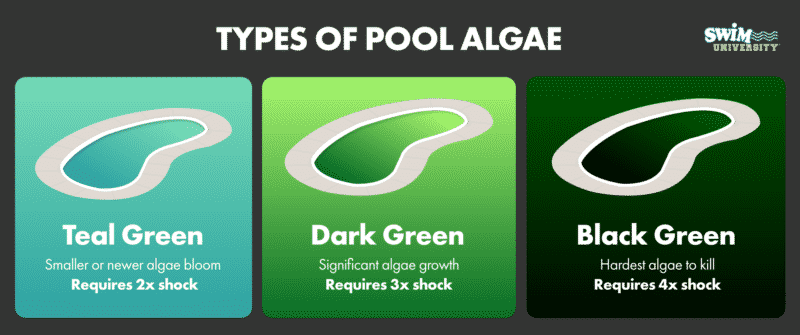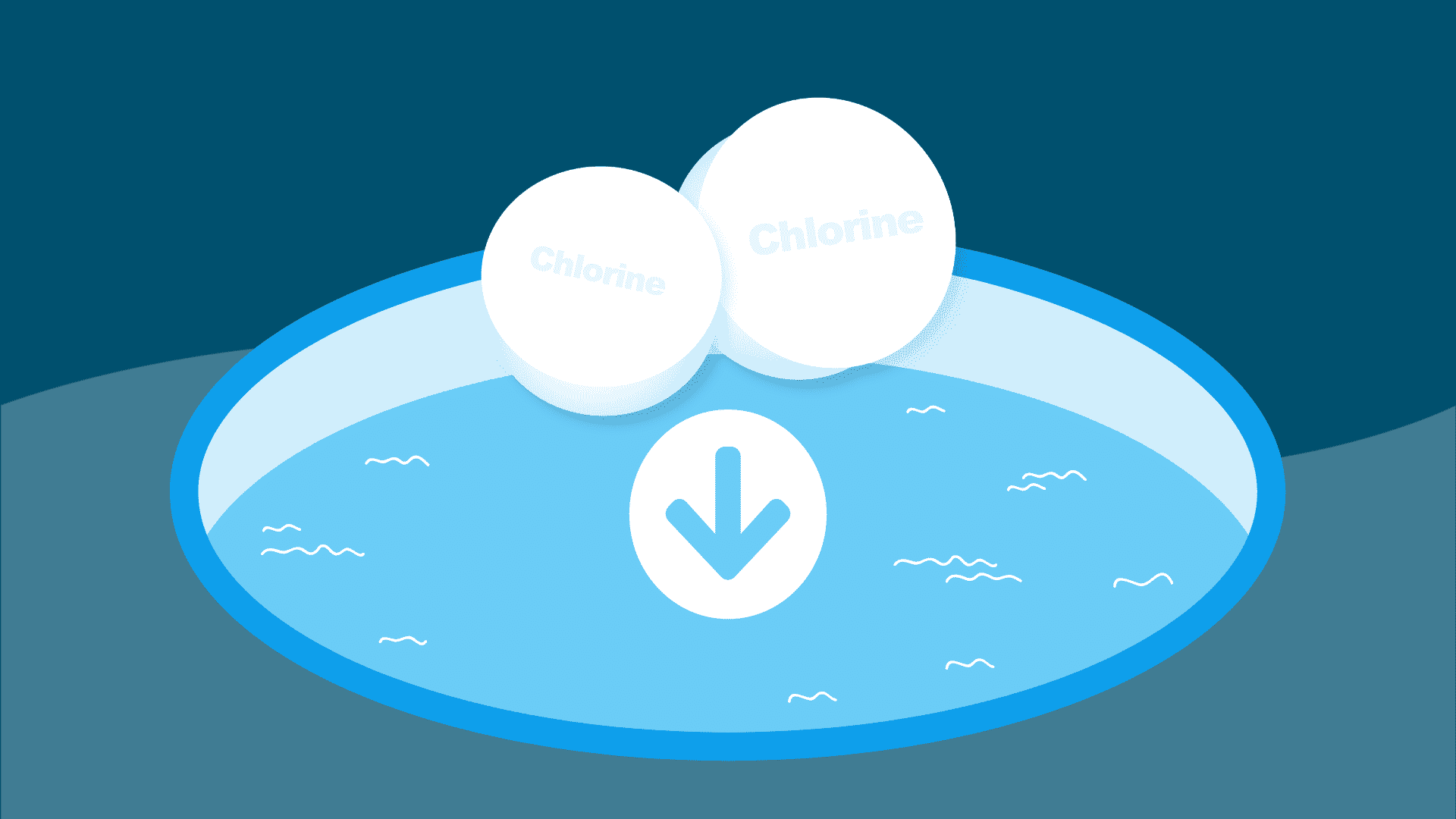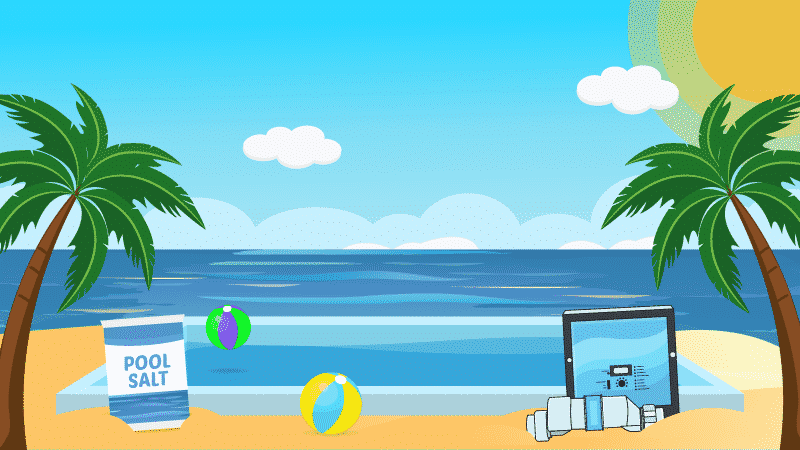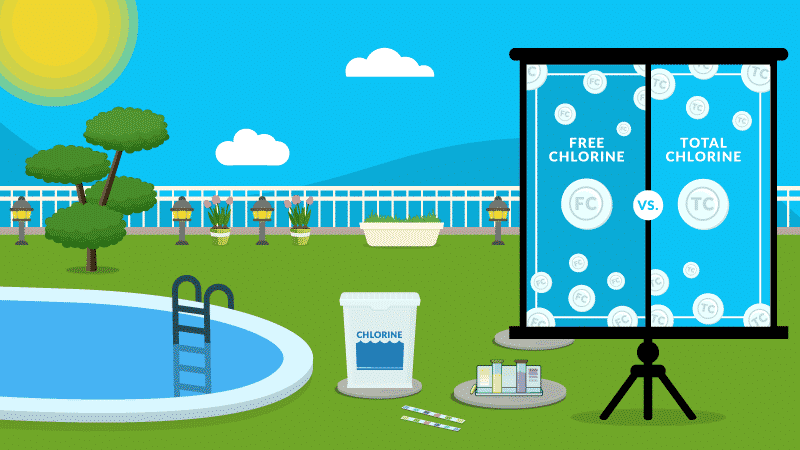How Much Shock Should You Add to Your Pool
Wondering how much shock to add to your pool? The exact amount you need to add depends on the size of your pool, the type of shock your using, and whether you’re shocking as part of regular pool maintenance, or treating an issue like algae.
Stop wasting time and money with confusing water chemistry and maintenance. Our effortless system guarantees to keep your pool balanced, sanitized, and crystal clear all year. Works for all pools including saltwater.
For general pool maintenance, add one pound of shock for every 10,000 gallons of water in your pool. But if you’re experiencing algae issues, you’ll need to add more shock:

- Light Green or Teal Green Pool Water (early-stage algae): Double shock your pool with two pounds of shock per 10,000 gallons.
- Darker Green (significant algae growth): Triple shock your pool with three pounds of shock per 10,000 gallons.
- Black Green (black algae and extreme growth): Quadruple shock your pool with four pounds of shock per 10,000 gallons.
Shocking your pool with a concentrated amount of chlorine is the most effective treatment for killing algae. An algaecide, on the other hand, is more effective at preventing algae in the first place.
What is Pool Shock and What Type Should You Use?
Shocking a pool is the process of adding a highly concentrated dose of chlorine to your swimming pool water. By quickly raising the level of free chlorine in the water, the pool shock kills algae, bacteria, contaminants, and chloramines.
There are several types of pool shocks on the market and what works well for one pool may not be the best choice for another. Here are the most common types of shock and when to add them:
Cal-Hypo Shock (Calcium Hypochlorite)
This fast-acting, quick-dissolving swimming pool shock kills bacteria, controls algae, and destroys organic contaminants in pools.
Cal-hypo shock is the strongest pool chlorine shock available. It’s the best choice for a strong treatment or if you’re combating algae. But because cal-hypo contains calcium, it can cause scale buildup in a salt generator. So if you’re a saltwater pool owner, use sparingly or consider another type of shock. You’ll also need to wait at least eight hours after shocking before you swim again. And unlike regular chlorine tablets or chlorine granules, cal-hypo shock is unstabilized chlorine. That means it’ll get destroyed by the sun’s UV rays, so you’ll need to use cal-hypo shock at night.
Dichlor Shock (Sodium Dichlor)
This multifunctional pool shock from Clorox comes in a 12-pack. The algae-fighting granules create crystal clear water by killing bacteria and organic contaminants. It works well for smaller pools and saltwater pools. As a dichlor-based stabilized cholorine shock, it does contain cyanuric acid.
Dichlor shock has less chlorine than cal-hypo shock, but it’s still effective. You can use it for weekly treatments or to battle algae issues. Though it won’t contribute to scale buildup, it will raise your cyanuric acid (CYA) levels. Because it contains CYA, it’s stabilized and that means you can it to your pool doing the day. But you still need to wait at least eight hours before you swim again.
Non-Chlorine Shock
A powerful oxidizing agent that eliminates combined non-sanitizing chlorine (chloramines) and provides higher free chlorine levels. Helps eliminate algae growth as well as harmful bacteria. Ideal for use with chlorine or bromine sanitized applications, weekly maintenance, and will not affect other chemical levels
Non-chlorine shock is a great option as a mild, weekly treatment. It won’t affect your calcium or cyanuric acid levels and you can swim shortly after using it. However, keep in mind that it’s not an effective way to treat severe algae problems, since it acts as an oxidizer but not a sanitizer.
How Much Shock Should You Add to Your Pool?
In general, add one pound of shock to your pool for every 10,000 gallons of water. But if you’re experiencing an algae problem, you’ll need to add double, triple, or quadruple the amount of shock. Regardless, always follow the manufacturer’s instructions when adding pool chemicals to your water.
The goal is to achieve breakpoint chlorination, which is the level of chlorine needed to remove algae, contaminants, and chloramines from the water. In general, chlorine levels that reach 30 ppm mean you’ve reached breakpoint chlorination.
If you have high pH levels, high CYA levels, or high water temperatures, you’ll need a higher concentration of chlorine, and the shock may take longer to remove all the algae, bacteria, and contaminants in the water.
If your pool’s volume makes the math complicated when you’re calculating how much shock to add, consider rounding up to ensure your pool gets enough chlorine. And if you need help calculating how many gallons of water your pool holds, check out our pool volume calculator.
You should add shock when your chlorine levels are unbalanced and you need to refresh your sanitizer. Shocking your pool will increase your free available chlorine levels and decrease your combined chlorine levels.
- Free Available Chlorine: The amount of chlorine available to kill bacteria and contaminants. It should be between 1 to 3 ppm.
- Combined Chlorine (Chloramines): This is the portion of total chlorine that has reacted with the microorganisms in the water. It should be no more than 0.2 ppm.
How to Add Shock to Your Pool
There are a few steps to consider before and after shocking your pool water.
1. Test Your Pool Water
Use a water test kit or test strips to check your pool’s water chemistry. Ideally, your pool’s pH level should be balanced (between 7.4 and 7.6) before shocking to maximize the results. However, some shocks may raise your pH, so it’s okay if it’s on the lower end. Also note your CYA and Calcium Hardness levels if you’re adding shock dichlor shock (that will impact CYA) or cal-hypo shock (that will impact Calcium). The normal ranges for your water chemistry should be:
- Total Alkalinity: 100 to 150 ppm
- pH: 7.4 to 7.6
- Calcium Hardness: 180 to 220 ppm
- Cyanuric acid (CYA): 30 to 50 ppm
2. Prepare the Shock
Like all pool chemicals, always add shock to your pool water with the right protective equipment. Wear goggles, rubber gloves, and long sleeve shirt and pants to protect your skin.
The package instructions will provide guidelines for application. Some products can be added directly to your pool, while others should be mixed in a bucket of water with a wooden stick before being broadcast to your pool.
3. Add Shock to Water
Always add your shock to the deepest part of your pool first. Use a pool brush to disperse the granules to prevent them from building up in a single spot.
If you notice cloudy water, after shocking your pool, don’t panic: a cloudy pool is a sign that the algae is dead. Vacuum your pool, run your filter and consider adding a pool clarifier.
Clears cloudy pool water by combining particles, making it easier for your filter to remove. Great for all pools. Also compatible with salt water pools.
Frequently Asked Questions About Pool Shock
Need more help with adding pool shock? Here are some common questions and answers.
Can a pool be shocked too much?
Yes, it is possible to add too much shock. And if you have a smaller pool, it can take much longer for the chlorine levels to drop. Be sure to test your ph and chlorine levels afterwards and do not use the pool until the chlorine has dropped back down to 3 ppm.
How many bags of shock do I need for a 10,000-gallon pool?
This depends on the type of shock you’re using and the size of the bag. Your package directions will provide information on how much to use for your pool volume. Use more to clear up algae.
How long should you run the filter after shocking a pool?
Keep your pool filter and pool pump running for at least 6 hours after shocking your swimming pool. This provides ample time for the filter to clean the water and allows the shock a time to fully circulate within the water. If you are battling algae, run your filter after shocking for anywhere from 24 hours to a full week, depending on how much algae you have.
How long does it take pool shock to work?
Pool shock needs 12 to 24 hours to work to kill algae. Wait at least eight hours after shocking before swimming again. Test your water again 24 hours after your treatment. Once your chlorine levels are within normal range, it’s safe for swimmers again.
Should I shock my pool every week?
Yes, you should shock your pool weekly as part of regular maintenance. This helps keep contaminants out of the water and prevents algae growth from taking over. You should also shock your pool after any heavy rain, or after a pool party where you’ve had a lot of people in the water.
Does shocking a pool raise the pH levels?
Cal-hypo shock will slightly raise your pH. The non-chlorine shock will not influence your pH.
Can I use bleach or liquid chlorine to shock my pool?
Many pool owners use bleach or liquid shock in their pools. Sodium hypochlorite, a.k.a. liquid shock, is a commercial-strength liquid chlorine. Containing 12.5 percent sodium hypochlorite, it’s stronger than store-bought bleach. Household bleach sold in one-gallon jugs contains 5 percent or less sodium hypochlorite. If you do use bleach to shock your pool, you’ll need to add significantly more than you would traditional pool shock to achieve higher chlorine levels.
3 Ways We Can Help With Your Pool
- The Pool Care Handbook: An illustrated guide to DIY pool care, including water chemistry, maintenance, troubleshooting, and more.
- The Pool Care Video Course: You’ll get 30+ step-by-step videos and a downloadable guide with everything you need to know about pool maintenance.
- The Pool Care App: Enter your water test results. Get a custom treatment plan. Know exactly what chemicals to add to keep your pool clear.
















